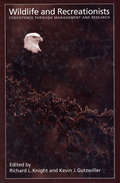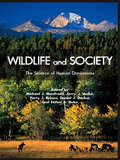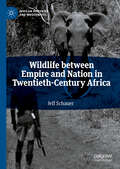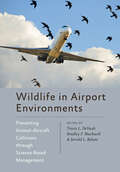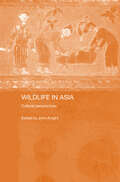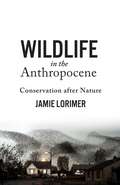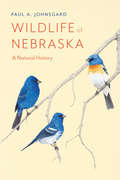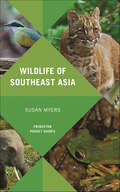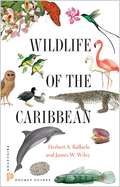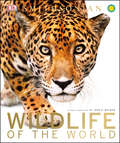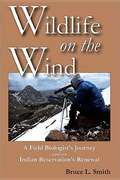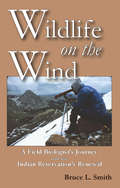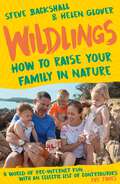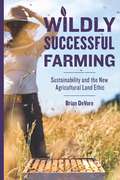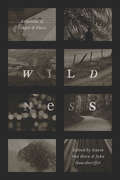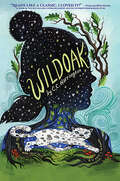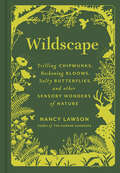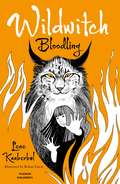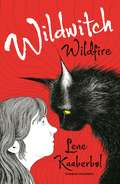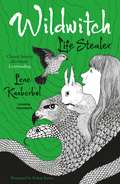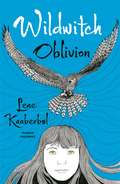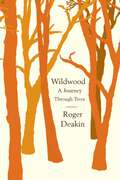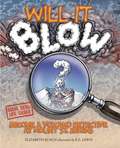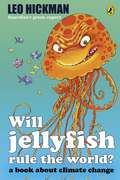- Table View
- List View
Wildlife and Recreationists: Coexistence Through Management And Research
by Joanna Burger Daniel J. Decker Richard L. Knight Kevin Gutzwiller H. Ken Cordell Paul KerlingerWildlife and Recreationists defines and clarifies the issues surrounding the conflict between outdoor recreation and the health and well-being of wildlife and ecosystems. Contributors to the volume consider both direct and indirect effects of widlife-recreationist interactions, including: *wildlife responses to disturbance, and the origins of these responses *how specific recreational activities affect diverse types of wildlife *the human dimensions of managing recreationists *the economic importance of outdoor recreation *how wildlife and recreationists might be able to coexist The book is a useful synthesis of what is known concerning wildlife and recreation. More important, it addresses both research needs and management options to minimize conflicts.
Wildlife and Society: The Science of Human Dimensions
by Daniel J. Decker Michael J. Manfredo Esther A. Duke Perry J. Brown Jerry J. VaskeWinner of The Wildlife Society's 2009 Wildlife Publication Award for outstanding edited book As human populations around the world continue to expand, reconciling nature conservation with human needs and aspirations is imperative. The emergence in recent decades of the academic field of human dimensions of fish and wildlife management is a proactive response to this complex problem. Wildlife and Society brings together leading researchers in the range of specialties that are relevant to the study of human dimensions of fish and wildlife work around the globe to provide theoretical and historical context as well as a demonstration of tools, methodologies, and idea-sharing for practical implementation and integration of practices. Chapters document the progress on key issues and offer a multifaceted presentation of this truly interdisciplinary field. The book * presents an overview of the changing culture of fish and wildlife management; * considers social factors creating change in fish and wildlife conservation; * explores how to build the social component into the philosophy of wildlife management; * discusses legal and institutional factors; * examines social perspectives on contemporary fish and wildlife management issues. Wildlife and Society is uniquely comprehensive in its approach to presenting the past, present, and future of human dimensions of fish and wildlife research and application. It offers perspectives from a wide variety of academic disciplines as well as presenting the views of practitioners from the United States, Europe, Africa, and Latin America. It is an important new reference for anyone concerned with fish and wildlife management or environmental conservation and protection.
Wildlife between Empire and Nation in Twentieth-Century Africa (African Histories and Modernities)
by Jeff SchauerThis book traces the emergence of wildlife policy in colonial eastern and central Africa over the course of a century. Spanning from imperial conquest through the consolidation of colonial rule, the rise of nationalism, and the emergence of neocolonial and neoliberal institutions, this book shows how these fundamental themes of the twentieth century shaped the relationships between humans and animals in what are today Kenya, Tanzania, Uganda, Zambia, and Malawi. A set of key themes emerges—changing administrative forms, militarization, nationalism, science, and a relentlessly broadening constituency for wildlife. Jeff Schauer illuminates how each of these developments were contingent upon the colonial experience, and how they fashioned a web of structures for understanding and governing wildlife in Africa—one which has lasted into the twenty-first century.
Wildlife in Airport Environments: Preventing Animal–Aircraft Collisions through Science-Based Management (Wildlife Management and Conservation)
by Travis L. DeVault Bradley F. Blackwell Jerrold L. BelantA comprehensive overview of wildlife issues facing airports and how to minimize conflicts.Winner of the NWRC Publication Award of the National Wildlife Research CenterThe pilot watches the instrument panel and prepares for touchdown—a routine landing until a burst of birds, a coyote, or a herd of deer crosses the runway! Every year, pilots experience this tension and many aircraft come into direct contact with birds and other wildlife, resulting in more than one billion dollars in damage annually. The United States Federal Aviation Administration has recorded a rise in these incidents over the past decade due to the combined effects of more reporting, rebounding wildlife populations, and an increased number of flights. Wildlife in Airport Environments tackles the issue of what to do about encounters with wildlife in and around airports—from rural, small-craft airparks to major international hubs. Whether the problem is birds or bats in the flight path or a moose on the runway, the authors provide a thorough overview of the science behind wildlife management at airports. This well-written, carefully documented volume presents a clear synthesis for researchers, wildlife managers, and airport professionals. The book belongs in the hands of all those charged with minimizing the risks that wildlife pose to air travel.Wildlife in Airport Environments is the first book in the series Wildlife Management and Conservation and is published in association with The Wildlife Society.ContributorsMichael L. Avery, U.S. Department of AgricultureJerrold L. Belant, Mississippi State UniversityKristin M. Biondi, Mississippi State UniversityBradley F. Blackwell, U.S. Department of AgricultureJonathon D. Cepek, U.S. Department of AgricultureLarry Clark, U.S. Department of AgricultureTara J. Conkling, Mississippi State UniversityScott R. Craven, University of Wisconsin–MadisonPaul D. Curtis, Cornell UniversityTravis L. DeVault, U.S. Department of AgricultureRichard A. Dolbeer, U.S. Department of AgricultureDavid Felstul, U.S. Department of the InteriorEsteban Fernández-Juricic, Purdue UniversityAlan B. Franklin, U.S. Department of AgricultureSidney A. Gauthreaux Jr., Clemson UniversityMichael Lavelle, U.S. Department of AgricultureJames A. Martin, Mississippi State UniversityRebecca Mihalco, U.S. Department of AgriculturePaige M. Schmidt, U.S. Fish and Wildlife ServiceThomas W. Seamans, U.S. Department of AgricultureKurt C. VerCauteren, U.S. Department of AgricultureBrian E. Washburn, U.S. Department of Agriculture
Wildlife in Asia: Cultural Perspectives (Man And Nature In Asia Ser. #Vol. 5)
by John KnightDrawing on anthropological and historical data, this book examines human-wildlife relations in China, Tibet, Japan, Bhutan, Indonesia, the Philippines, Malaysia, India, Thailand and Vietnam. The volume initially focuses on the various ways in which wild animals are exploited as a resource, for food, medicine and crop-picking labour, before examining animals termed as pests or predators that are deemed to be harmful and dangerous. Bringing together anthropologists and historians, this book analyses the range, variability and historical mutability of human sensibilities towards animals in Asia and will be of interest to Asianists and anthropologists alike.
Wildlife in the Anthropocene: Conservation after Nature
by Jamie LorimerElephants rarely breed in captivity and are not considered domesticated, yet they interact with people regularly and adapt to various environments. Too social and sagacious to be objects, too strange to be human, too captive to truly be wild, but too wild to be domesticated—where do elephants fall in our understanding of nature? In Wildlife in the Anthropocene, Jamie Lorimer argues that the idea of nature as a pure and timeless place characterized by the absence of humans has come to an end. But life goes on. Wildlife inhabits everywhere and is on the move; Lorimer proposes the concept of wildlife as a replacement for nature. Offering a thorough appraisal of the Anthropocene—an era in which human actions affect and influence all life and all systems on our planet— Lorimer unpacks its implications for changing definitions of nature and the politics of wildlife conservation. Wildlife in the Anthropocene examines rewilding, the impacts of wildlife films, human relationships with charismatic species, and urban wildlife. Analyzing scientific papers, policy documents, and popular media, as well as a decade of fieldwork, Lorimer explores the new interconnections between science, politics, and neoliberal capitalism that the Anthropocene demands of wildlife conservation. Imagining conservation in a world where humans are geological actors entangled within and responsible for powerful, unstable, and unpredictable planetary forces, this work nurtures a future environmentalism that is more hopeful and democratic.
Wildlife of Nebraska: A Natural History
by Paul A. JohnsgardIn Wildlife of Nebraska: A Natural History, Paul A. Johnsgard surveys the variety and biology of more than six hundred Nebraska species. Narrative accounts describe the ecology and biology of the state&’s birds, its mammals, and its reptiles and amphibians, summarizing the abundance, distributions, and habitats of this wildlife. To provide an introduction to the state&’s major ecosystems, climate, and topography, Johnsgard examines major public-access natural areas, including national monuments, wildlife refuges and grasslands, state parks and wildlife management areas, and nature preserves. Including more than thirty-five line drawings by the author along with physiographic, ecological, and historical maps, Wildlife of Nebraska is an essential guide to the wildlife of the Cornhusker State.
Wildlife of Southeast Asia (Princeton Pocket Guides)
by Susan MyersThis handy photographic guide offers a stunning look at the wildlife of Southeast Asia, which includes Burma, Thailand, Laos, Cambodia, Vietnam, West Malaysia, and Singapore. Accessible text and more than 500 color photographs help readers to learn about and identify the most common species found in the region, particularly the mammals, birds, reptiles, amphibians, and insects that visitors will most likely encounter. Detailed photos are accompanied on facing pages by succinct species accounts highlighting key identification features, status, and distribution. The book's brief introduction offers readers useful information on major wildlife sites as well as practical advice on making the most of a wildlife-watching trip.Wildlife of Southeast Asia is the essential resource for visitors and residents interested in the fauna of this fascinating area of the world.A photographic guide to the wildlife of Southeast Asia, including Burma, Thailand, Laos, Cambodia, Vietnam, West Malaysia, and SingaporeMore than 500 stunning color photographsAccessible species accounts highlight key identification features, status, and distributionA brief introduction discusses wildlife locations and practical travel know-how
Wildlife of the Caribbean (Princeton Pocket Guides)
by James Wiley Herbert RaffaeleThis is the first comprehensive illustrated guide to the natural world of the Caribbean islands. It contains 600 vivid color images featuring 451 species of plants, birds, mammals, fish, seashells, and much more. While the guide primarily looks at the most conspicuous and widespread species among the islands, it also includes rarely seen creatures―such as the Rhinoceros Iguana and Cuban Solenodon―giving readers a special sense of the region's diverse wildlife. <p><p> Each species is represented by one or more color photos or illustrations; details regarding its identification, status, and distribution; and interesting aspects of its life history or relationship to humans. In addition, an introductory section focuses on the unique characteristics of the Caribbean’s fauna and flora, the threats faced by both, and some of the steps being taken to sustain the area’s extraordinary natural heritage.
Wildlife of the World (DK Wonders of the World)
by DKExperience the full force of nature with this stunning visual encyclopedia celebrating the world&’s most wonderful wildlife. With an inspiring foreword by leading naturalist and wildlife photographer Chris Packham, this epic adventure takes you across the continents to meet all creatures big and small. You&’ll visit the deserts of Australia, the grasslands of Africa, the rainforests of South America, the mountains of Asia, and the coral reefs of Australia on this mind-blowing tour to meet the incredibly diverse range of life on Earth. Breathtaking photography, animal profiles, accessible maps, and facts and stats combine to create this standout reference title. Revealing a wealth of species across hundreds of spectacular pages, Wildlife of the World introduces you to animals that roam, swim, and fly in each and every part of our planet.Calling all globe-trotters, nature enthusiasts, and biology students, this is your chance to experience the animal kingdom as never before and gain an absolutely essential addition to your home library.Produced in association with the Smithsonian Institution.
Wildlife on the Wind
by Bruce L. SmithIn the heart of Wyoming sprawls the ancient homeland of the Eastern Shoshone Indians, who were forced by the U. S. government to share a reservation in the Wind River basin and flanking mountain ranges with their historical enemy, the Northern Arapahos. Both tribes lost their sovereign, wide-ranging ways of life and economic dependence on decimated buffalo. Tribal members subsisted on increasingly depleted numbers of other big gamedeer, elk, moose, pronghorn, and bighorn sheep. In 1978, the tribal councils petitioned the U. S. Fish and Wildlife Service to help them recover their wildlife heritage. Bruce Smith became the first wildlife biologist to work on the reservation. Wildlife on the Wind recounts how he helped Native Americans change the course of conservation for some of America's most charismatic wildlife.
Wildlife on the Wind: A Field Biologist's Journey and an Indian Reservation's Renewal (G - Reference, Information And Interdisciplinary Subjects Ser.)
by Bruce L. SmithIn the heart of Wyoming sprawls the ancient homeland of the Eastern Shoshone Indians, who were forced by the U.S. government to share a reservation in the Wind River basin and flanking mountain ranges with their historical enemy, the Northern Arapahos. Both tribes lost their sovereign, wide-ranging ways of life and economic dependence on decimated buffalo. Tribal members subsisted on increasingly depleted numbers of other big game—deer, elk, moose, pronghorn, and bighorn sheep. In 1978, the tribal councils petitioned the U.S. Fish and Wildlife Service to help them recover their wildlife heritage. Bruce Smith became the first wildlife biologist to work on the reservation. Wildlife on the Wind recounts how he helped Native Americans change the course of conservation for some of America's most charismatic wildlife.
Wildlings: How to raise your family in nature
by Steve Backshall Helen GloverThe ultimate handbook for raising wilder, happier, muddier, more resilient kids - whatever the weather and wherever you live.In the last few years parents everywhere have realised how crucial the freedom of the outside world is, not only for their kids' wellbeing, but the whole family's. They've also realised, however, that it's not always that easy. That's where this book comes in. Taking you through different environments and activities to explore, from minibeasts in the garden and pond dipping all the way through to beach Olympics and sea swimming (via rainy days, wild woods and river exploration), there are ideas small and big for all ages that will get them - and you - more engaged and involved with nature, and the wildlife in it.With contributions from;Bear Grylls on embracing adventure, Ed Stafford on flirting with danger , Sir Chris Hoy on riding bikes, Judy Murray on rainy day kitchen games, Michaela Strachan on creative word games, Gordon Buchanan on toasting marshmallows, Caroline Lucas on protecting the planet, Wayne Bridge on garden football,and many more, Wildlings is a map to a more adventurous, wilder future.
Wildly Successful Farming: Sustainability and the New Agricultural Land Ethic
by Brian DeVoreWildly Successful Farming tells the stories of farmers across the American Midwest who are balancing profitability and food production with environmental sustainability and a passion for all things wild. They are using innovative techniques and strategies to develop their "wildly" successful farms as working ecosystems. Whether producing grain, vegetables, fruit, meat, or milk, these next-generation agrarians look beyond the bottom line of the spreadsheet to the biological activity on the land as key measures of success. Written by agricultural journalist Brian DeVore, the book is based on interviews he has conducted at farms, wildlife refuges, laboratories, test plots, and gardens over the past twenty-five years. He documents innovations in cover cropping, managed rotational grazing, perennial polyculture, and integrated pest management. His accounts provide insight into the impacts regenerative farming methods can have on wildlife, water, landscape, soils, and rural communities and suggest ways all of us can support wildly successful farmers.
Wildness: Relations of People & Place
by John Hausdoerffer Gavin Van Horn and John HausdoerfferWhether referring to a place, a nonhuman animal or plant, or a state of mind, wild indicates autonomy and agency, a will to be, a unique expression of life. Yet two contrasting ideas about wild nature permeate contemporary discussions: either that nature is most wild in the absence of a defiling human presence, or that nature is completely humanized and nothing is truly wild. This book charts a different path. Exploring how people can become attuned to the wild community of life and also contribute to the well-being of the wild places in which we live, work, and play, Wildness brings together esteemed authors from a variety of landscapes, cultures, and backgrounds to share their stories about the interdependence of everyday human lifeways and wildness. As they show, far from being an all or nothing proposition, wildness exists in variations and degrees that range from cultivated soils to multigenerational forests to sunflowers pushing through cracks in a city alley. Spanning diverse geographies, these essays celebrate the continuum of wildness, revealing the many ways in which human communities can nurture, adapt to, and thrive alongside their wild nonhuman kin. From the contoured lands of Wisconsin’s Driftless region to remote Alaska, from the amazing adaptations of animals and plants living in the concrete jungle to indigenous lands and harvest ceremonies, from backyards to reclaimed urban industrial sites, from microcosms to bioregions and atmospheres, manifestations of wildness are everywhere. With this book, we gain insight into what wildness is and could be, as well as how it might be recovered in our lives—and with it, how we might unearth a more profound, wilder understanding of what it means to be human.Wildness: Relations of People and Place is published in association with the Center for Humans and Nature, an organization that brings together some of the brightest minds to explore and promote human responsibilities to each other and the whole community of life. Visit the Center for Humans and Nature's Wildness website for upcoming events and a series of related short films.
Wildoak
by C. C. HarringtonGive the gift of connection this holiday season with this lushly illustrated story of a girl and a snow leopard and their unlikely friendship. <p><p>Maggie Stephens's stutter makes school especially hard. She will do almost anything to avoid speaking in class or calling attention to herself. So when her unsympathetic father threatens to send her away for so-called "treatment," she reluctantly agrees to her mother's intervention plan: a few weeks in the fresh air of Wildoak Forest, visiting a grandfather she hardly knows. It is there, in an extraordinary twist of fate, that she encounters an abandoned snow leopard cub, an exotic gift to a wealthy Londoner that proved too wild to domesticate. But once the cub's presence is discovered by others, danger follows, and Maggie soon realizes that time is running out, not only for the leopard, but for herself and the forest as well. <p><p>Told in alternating voices, Wildoak shimmers with beauty, compassion, and unforgettable storytelling as it explores the delicate interconnectedness of the human, animal, and natural worlds.
Wildscape: Trilling Chipmunks, Beckoning Blooms, Salty Butterflies, and other Sensory Wonders of Nature
by Nancy LawsonFrom Nancy Lawson, author of The Humane Gardener, a first-of-its-kind guide that takes readers on an insightful and personal exploration of the secret lives of animals and plants.Master naturalist Nancy Lawson takes readers on a fascinating tour of the vibrant web of nature outside our back door—where animals and plants perceive and communicate using marvelous sensory abilities we are only beginning to understand. Organized into chapters investigating each of their five senses, Lawson's exploration reveals a remarkable world of interdependent creatures with amazing capabilitiesYou'll learn of ultrasound clicks humans can't hear, and ultraviolet colors humans can't see. You'll cross paths with foraging American bumblebees drawn to the scent of wild bergamot, urban sparrows who adapt their mating song in response to human clamor, trees that amp up their growth in response to deer and moose saliva, and a chipmunk behaving like the world's smallest pole vaulter to nab juicy red berries hanging from the lowest parts of a coral honeysuckle vine.Synthesizing cutting-edge scientific research, original interviews with animal and plant researchers, and poetic observations made in her own garden, Lawson shows us how to appreciate the natural environment from the sensory perspective of our wild neighbors right outside our door and beyond, and how to respect and nurture the habitats they need to survive.
Wildwitch: Volume Four
by Lene Kaaberbol Charlotte Barslund Rohan EasonFrom Lene Kaaberbøl, known as the Danish J.K. Rowling: Book four in the Wildwitch series, an acclaimed new children's fantasy series about a young girl who can communicate with and control the natural world.As Clara turns thirteen she must complete a daunting challenge in order to become a fully-fledged wildwitch, but a series of frightening attacks on her family are distracting her from the crucial task ahead of her.Clara searches for the source of the danger and finds herself drawn further and further into the mystery, towards a deadly battle with Bravita Bloodling that will leave her changed for ever.From the Trade Paperback edition.
Wildwitch: Volume One
by Lene Kaaberbol Charlotte Barslund Rohan EasonFrom Lene Kaaberbøl, known as the Danish J.K. Rowling: Book one in the Wildwitch series, an acclaimed new children's fantasy series about a young girl who can communicate with and control the natural world.Twelve-year-old Clara is an ordinary girl, so small and shy that her mum calls her Little Mouse. Then, one day, she meets a cat. A huge, strange, black cat, with glowing yellow eyes. And so begins her new life as a wildwitch.Suddenly, Clara is plunged into a world of mystery and magic. With her Aunt Isa to guide her, she finds she can talk to animals and walk the mysterious Wildways. But then she is captured by the dreaded Chimera...From the Trade Paperback edition.
Wildwitch: Volume Three
by Lene Kaaberbol Charlotte Barslund Rohan EasonFrom Lene Kaaberbøl, known as the Danish J.K. Rowling: Book three in the Wildwitch series, an acclaimed new children's fantasy series about a young girl who can communicate with and control the natural world.A sparrow flitting under the forest canopy, a snake slithering on its belly across a carpet of leaves, a hawk swooping down on a squirrel: Clara finds herself drawn into a variety of animal minds and caught up in a deadly dance of predator and prey.The dramatic and mysterious third part in the Wildwitch story sees Clara discover more about her magical powers and about herself, as an unexpected and frightening new danger emerges from the shadows.From the Trade Paperback edition.
Wildwitch: Volume Two
by Lene Kaaberbol Charlotte Barslund Rohan EasonFrom Lene Kaaberbøl, known as the Danish J.K. Rowling: Book two in the Wildwitch series, an acclaimed new children's fantasy series about a young girl who can communicate with and control the natural world.Barely recovered from her escapades of the previous year, Clara is just getting used to her new wildwitch identity, as well as to her mysterious new companion, Cat, when she is thrust into a new adventure. First, Clara's friend Shanaia is found badly injured, then Clara's best friend Oscar goes missing - kidnapped.With no one to help her, Clara must journey on the Wildways to the windswept clifftop dwelling of Westmark. Here she will have to draw on her wildwitch powers, and discover new reserves of inner strength, as she once again faces her enemy, Chimera.From the Trade Paperback edition.
Wildwood: A Journey Through Trees
by Roger DeakinHere, published for the first time in the United States, is the last book by Roger Deakin, famed British nature writer and icon of the environmentalist movement. In Deakin's glorious meditation on wood, the "fifth element" -- as it exists in nature, in our culture, and in our souls -- the reader accompanies Deakin through the woods of Britain, Europe, Kazakhstan, and Australia in search of what lies behind man's profound and enduring connection with trees. Deakin lives in forest shacks, goes "coppicing" in Suffolk, swims beneath the walnut trees of the Haut-Languedoc, and hunts bushplums with Aboriginal women in the outback. Along the way, he ferrets out the mysteries of woods, detailing the life stories of the timber beams composing his Elizabethan house and searching for the origin of the apple. As the world's forests are whittled away, Deakin's sparkling prose evokes woodlands anarchic with life, rendering each tree as an individual, living being. At once a traveler's tale and a splendid work of natural history, Wildwood reveals, amid the world's marvelous diversity, that which is universal in human experience.
Will China Save The Planet?
by Barbara FinamoreNow that Trump has turned the United States into a global climate outcast, will China take the lead in saving our planet from environmental catastrophe? Many signs point to yes. China, the world's largest carbon emitter, is leading a global clean energy revolution, phasing out coal consumption and leading the development of a global system of green finance. <p><p> But as leading China environmental expert Barbara Finamore explains, it is anything but easy. The fundamental economic and political challenges that China faces in addressing its domestic environmental crisis threaten to derail its low-carbon energy transition. Yet there is reason for hope. China's leaders understand that transforming the world's second largest economy from one dependent on highly polluting heavy industry to one focused on clean energy, services and innovation is essential, not only to the future of the planet, but to China's own prosperity.
Will It Blow?: Become a Volcano Detective at Mount St. Helens
by Elizabeth RuschThis book helps the reader to become a volcano detective who can decipher volcanic clues,with real life cases from Mount St. Helens.
Will Jellyfish Rule the World?: A Book About Climate Change
by Leo HickmanFrom what makes Earth so special, to how scientists know for sure our climate is changing, why it's a big deal for everyone and what we can all do right now to make a difference, green expert Leo Hickman is ready to answer all your questions.Will Jellyfish Rule the World? breaks down the causes and effects of climate change in a fresh, fun and easy-to-follow format. Packed with practical everyday things we can all do right now to make a difference, Will Jellyfish Rule the World? is a comprehensive, easy-to-use eco-handbook for budding classroom environmentalists everywhere.
